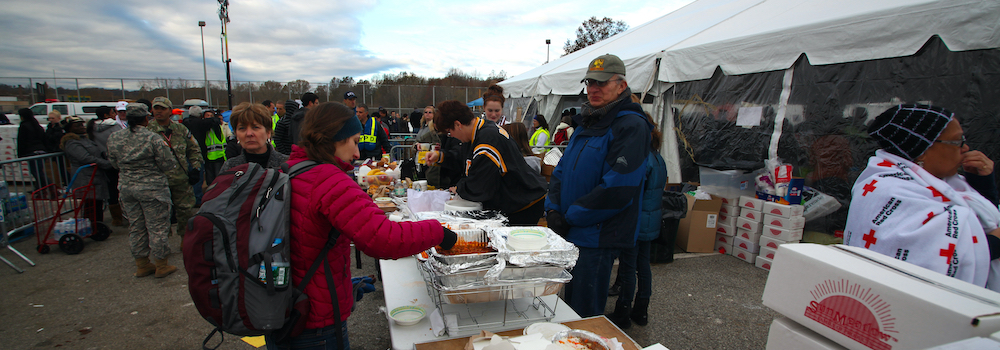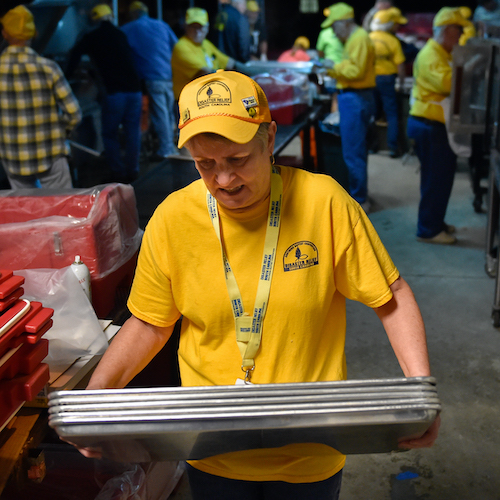 National Guard members and community groups help serve food to those impacted by Hurricane Sandy in Staten Island. ©A. Katz, 2012.
National Guard members and community groups help serve food to those impacted by Hurricane Sandy in Staten Island. ©A. Katz, 2012.
Implications for Public Health
Building relationships between public health agencies and community-based organizations before disasters can increase individual and collective capacity to provide assistance when needed most.
Relationships are hard, but succeeding without them is harder. This is true for individuals, but it is even more essential for organizations that serve the public. It is difficult, though, to create new relationships in times of duress. Public health emergency planners—who are responsible for coordinating mass care, ensuring accessibility, and monitoring health concerns in shelters—need to have critical relationships in place before the next disaster. Establishing interorganizational relationships that include community- and faith-based organizations aren’t just an essential element of their jobs, they make their job easier when it counts most.
Fundamentally, all disasters and public health emergencies are local events and, paradoxically, the larger the scale of the disaster, the more local the response. Response to the COVID-19 pandemic is an excellent example of why local relationships matter. When the capacities of all localities are strained at varying levels, effective local relationships can strengthen the emergency response by helping to maximize information and resource sharing.
It’s essential to dispel a common misconception about what community-based groups want when they enter into interorganizational relationships with local government. The presumed answer is that community groups must want something costly—funding, supplies, training, or money.
The reality is far different. How do we know? We asked them. The research team I was a part of at University of California, Los Angles conducted key informant interviews with community-based organizations active in disasters. Even though these community-based groups cut across jurisdictional population density, organizational mission and purpose, geographic region, and other traits, they shared a common desire. In our study, we found that the primary aim of these groups is to be treated as respected partners.
Partnerships That Work
Community groups have much to offer local disaster planning and response agencies and just want a seat at the table so they can effectively contribute. And in many cases, especially within specific populations, they could be better equipped to do so than local governments.
From our research, a good example of partnership emerged. A community center in the Pacific Northwest reported that they developed the trust of a large immigrant population in their geographical community. They had credibility and mutual respect. They had cultural and linguistic competence. The center had facilities and space and volunteers. When the H1N1 pandemic and the Severe Acute Respiratory Syndrome (SARS) crises were unfolding, the community center had a great deal more to offer the response than what the local public health department asked them for, which was information dissemination. The community center knew they had more to offer, but because they weren’t present in planning, the health department didn’t. The same is often true with disability services organizations, amateur radio clubs, houses of worship, Community Emergency Response Team (CERT) volunteers, and other groups.
 The American Red Cross and volunteers from Harleyville First Baptist Church partnered to provide hot meals for those impacted by Hurricane Matthew in South Carolina. ©U.S. Air Force/Gracie Olson, 2016.
The American Red Cross and volunteers from Harleyville First Baptist Church partnered to provide hot meals for those impacted by Hurricane Matthew in South Carolina. ©U.S. Air Force/Gracie Olson, 2016.
When relationships are established before emergencies, everyone involved has a better sense of each other’s capabilities and can increase their individual and collective capacities. A promising example of this was developed in Southern California when a local health department collaborated with student volunteers from a local school of public health. When the use of medication points-of-dispensing increased in response to flu pandemic planning, the local health department was able to address their staffing needs by using supervised graduate student volunteers for tasks that did not require special training or certification, such as helping community members with intake and screening. This included completing forms, identifying any allergies or contraindications for the vaccine, and serving as translators.
How to Build Strong Relationships
There is clearly much to be gained by cooperating with community partners, but it does cost time. There is no denying that staff time matters and may be in short supply for often understaffed public health departments. While our research points to the fact that it’s worth the time and effort to create and expand relationships, the problem is that the payoff isn't always fully realized until a disaster creates unmet needs. This can lead local government agencies to perceive that the investment in such relationships may never payoff. Our research, though, indicates that relationships are worth the investment over time even if their dividends are not immediately evident.
To learn more and increase relationship-building skills, local disaster and public health emergency planners might consider conducting a social network analysis (with a social network map) among their local community organizations active in disasters and invest in steps to improve their social network measures. Similarly, dedicated staff familiar with social networks and group dynamics would be ideal to manage relationships. There is an untapped body of knowledge from organizational studies that could be leveraged to help manage and facilitate interorganizational relationships.
Organizations that can’t devote staff or funds to such endeavors can still improve their interorganizational relationships using available resources. The Assessment for Disaster Engagement with Partners Toolkit (ADEPT) is a great resource created by the University of California, Los Angeles Fielding School of Public Health, and the RAND Corporation has put together the ENGAGED Toolkit. Both resources can help guide disaster and public health emergency planners in evaluating partnerships and promoting collaboration.
Yes, relationships are hard. Yes, they take time and effort. They’re worth it, though. The power of relationships becomes readily apparent when a disaster displaces local populations, creating needs for mass care. When they are needed most, stakeholders will be glad that they put forth the effort on the front end.
Suggested Tools
CERT Basic Training Participant Manual
Federal Emergency Management Agency
The Community Emergency Response Team (CERT) Basic Training manual helps train and organize teams of volunteers to assist their communities during emergencies. The manual focuses on, among other important topics, the provision of mass care and distribution of information is emergency shelters.
Assessment for Disaster Engagement with Partners Tool
UCLA Center for Public Health and Disasters
An assessment tool that helps local health departments evaluate their partnership activities with community and faith-based organizations and provides recommendations to enhance local collaboration efforts.
ENGAGED Toolkit
RAND Corporation
A toolkit designed to improve the engagement of nongovernmental organizations (NGOs)—specifically, voluntary associations, philanthropic organizations, advocacy groups, community groups, and businesses—in disaster response and recovery. The toolkit provides suggestions on the different goods and services that NGOs can provide to community members who are sheltering during a disaster.
For a list of all the tools included in this special collection, visit the Mass Sheltering Tool Index. A list of further readings are also available.
Michael Stajura studied disaster sociology and public health emergencies at the University of California, Los Angeles. He has also published several widely syndicated essays relating to being a former foster youth who earned a PhD and on his experience of going from homelessness to graduating from West Point and becoming a U.S. Army officer in five years. Stajura currently works for the State of California.